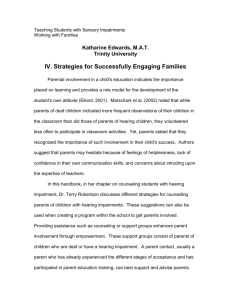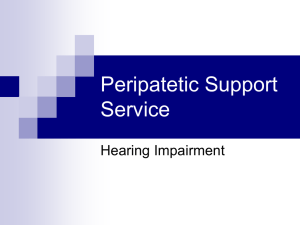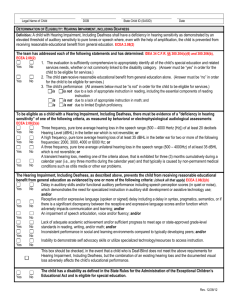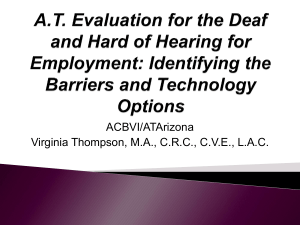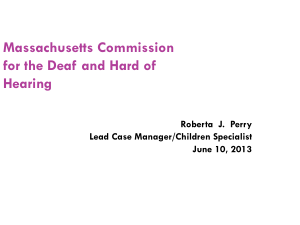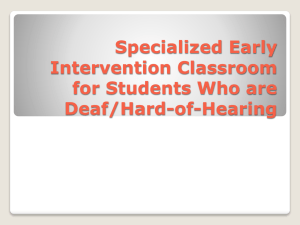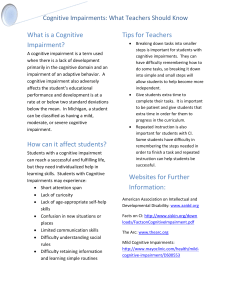Improving Classroom Behaviors and Social Interactions
advertisement
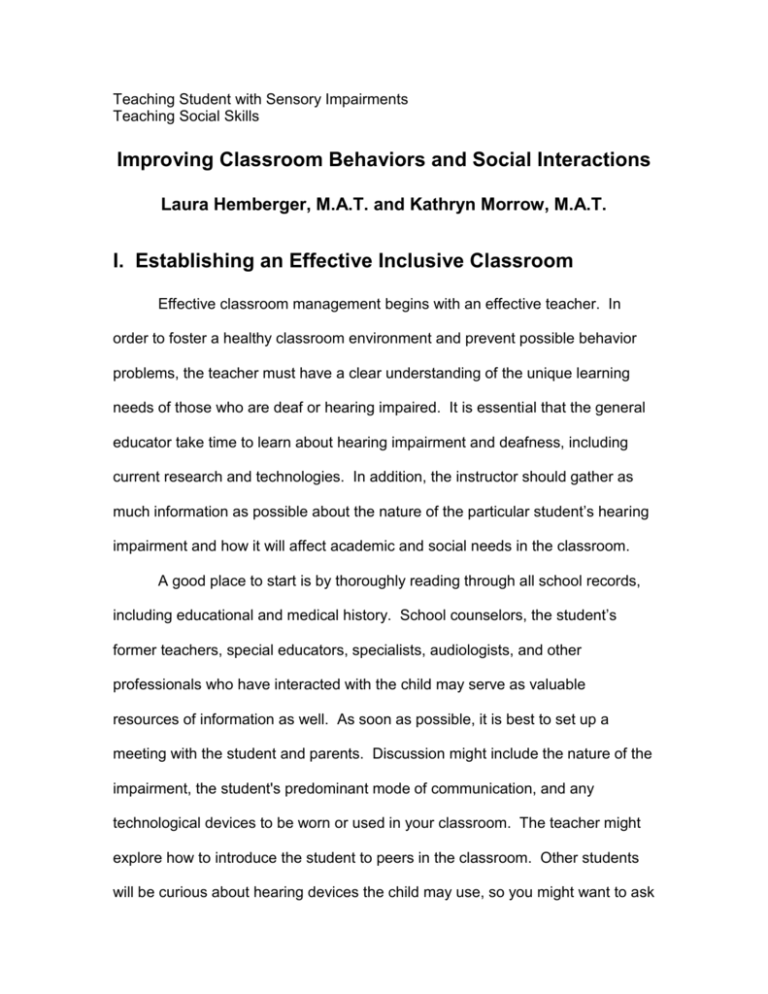
Teaching Student with Sensory Impairments Teaching Social Skills Improving Classroom Behaviors and Social Interactions Laura Hemberger, M.A.T. and Kathryn Morrow, M.A.T. I. Establishing an Effective Inclusive Classroom Effective classroom management begins with an effective teacher. In order to foster a healthy classroom environment and prevent possible behavior problems, the teacher must have a clear understanding of the unique learning needs of those who are deaf or hearing impaired. It is essential that the general educator take time to learn about hearing impairment and deafness, including current research and technologies. In addition, the instructor should gather as much information as possible about the nature of the particular student’s hearing impairment and how it will affect academic and social needs in the classroom. A good place to start is by thoroughly reading through all school records, including educational and medical history. School counselors, the student’s former teachers, special educators, specialists, audiologists, and other professionals who have interacted with the child may serve as valuable resources of information as well. As soon as possible, it is best to set up a meeting with the student and parents. Discussion might include the nature of the impairment, the student's predominant mode of communication, and any technological devices to be worn or used in your classroom. The teacher might explore how to introduce the student to peers in the classroom. Other students will be curious about hearing devices the child may use, so you might want to ask whether the student would be willing to show the class how to use the instrument and how it helps communication. If possible, this should occur as the child is integrated into the classroom in order to insure a smooth transition for all. Classroom community has a considerable effect on both learning and behavior. The general education teacher must intentionally foster a positive classroom environment for the student. This begins with helping hearing students learn about hearing loss and deafness. The teacher might invite a guest speaker or someone knowledgeable about hearing impairment to educate peers about the disability. Students should have the opportunity to ask questions and to be introduced to any adaptations the child may use to aid communication, such as an FM system or an interpreter (Mullis & Otwell, 1998). The importance of such education is that it breeds tolerance and a fuller understanding of individual diversity. Teachers should require students to respect one another’s differences. It is important to employ a zero-tolerance teasing policy in your classroom to insure that no student will be isolated or ostracized for his or her uniqueness. I - A. Strategies for Effective Communication In addition to being educated about hearing impairment, all students in the classroom should be taught ways to effectively communicate and any modifications they can make to more fully include the student in classroom activities. Often, hearing students call on the teacher for help when they have difficulty communicating with a student who is hearing impaired (Mullis & Otwell, 1998). Below are some suggested strategies students can use to communicate: 1. Always face the student whom you are addressing; 2. Make sure you have the student’s attention before you start speaking; 3. Do not speak too loudly or exaggerate lip movements for the student who is lip-reading; 4. Repeat or rephrase the message if the student seems confused; 5. Write down the message you are trying to communicate; 6. Act out the message or use visual cues or symbols; 7. Do not become frustrated, aggravated, or say “never mind” when communication is difficult; 8. Look for activities where less talk is required, such as sports, computers, puzzles, or board games. Because of inherent differences in communication, it is likely that there will be times in your classroom when a student with hearing loss will misinterpret orally-presented information or need to ask for extra clarification. Make it clear to students that all questions are welcome, and students are encouraged to seek the help they need, both from you and from one another. Many teachers prefer to set up a classroom "buddy" for a student with special learning needs. While this approach may work well in your classroom, it is important to remember that no one student should be taking the sole responsibility of helping another. Fostering a helping and collaborative environment for all students ensures that all will grow not only academically, but socially as well. I - B. Cooperative Learning Cooperative learning is a valuable way to engage all members of the learning community and promote meaningful social interaction as students work together to achieve a common goal. Teachers of students with hearing impairments should utilize cooperative learning frequently to encourage communication. The following are suggestions for organizing group work in the classroom: 1. Keep groups small to prompt conversation and interaction; 2. Seat students at round tables where all faces are visible (Oral Deaf Education Homepage, 2005); 3. Make use of visual and/or tactile resources so that the child with hearing impairment can become more fully involved; 4. Assign roles to group members so that each student will have the chance to participate. You may want to practice using these roles before expecting students to do so on their own; 5. Reinforce positive interactions as they occur during group work time. I - C. Establishing Expectations for Student Performance Finally, students are very aware of their teacher’s expectations for them. Part of creating a positive classroom environment is maintaining high, yet reasonable, expectations for all students, emphasizing the belief that everyone can and will learn. In the case of students with special needs such as hearing impairment, teachers must take care to apply the same standards as to the rest of the class. This means not doing for students what they can do for themselves, as well as calling on students who are deaf or hearing impaired with the same frequency and in the same manner as hearing students. If students believe that a teacher does not call on them or only directs simple questions to them, the message is that they are not capable of the intellectual work expected of the other students. Such a belief about oneself may produce apathy or anger, manifested as behavioral problems (Mullis & Otwell, 1998; Oral Deaf Education Homepage, 2005).

